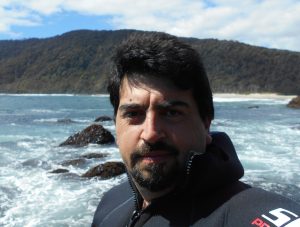IFOP researchers attend at VI National Aquaculture Congress
August 31st, 2017
Dr.Pablo Rojas
Between January 17th and 20th, the VI National Aquaculture Congress was held in Viña del Mar, with an emphasis on Research for Diversification and Sustainability. The meeting was organized and carried out in University Andrés Bello premises.
On that occasion, IFOP researchers Pablo Rojas and David Opazo presented their work at the Congress
Dr. Pablo Rojas presented the work Development of a model to evaluate the load capacity in the Inland Sea of Chiloé: Advances and Challenges, which is a complement to a study that seeks to know the environmental performance of aquaculture in Chile.
The presentation was aimed to show the advances made in the analysis of environmental information (such as temperature, salinity, oxygen, phytoplankton, zooplankton, nutrients, among others) and the methodology used to explore and ascertain a physic-biological coupling model based on the consumption and/ or availability of oxygen in the water column, which would allow the estimation by physical variability (circulation and transport) and biological (consumption and/ or oxygen availability), load capacity or tolerance levels of water bodies in front of the incorporation of organic material and metabolic wastes derived from fish culture.
The study is based on bio-oceanographic information that rises in the inland sea of Chiloé, in order to have a first approximation regarding the environmental state of the study area. The results of the analysis of the different environmental variables were incorporated into a biogeochemical model connected to a bio-optical model. Simulations of phytoplankton growth, zooplankton-phytoplankton grazing, phytoplankton mortality, among others, were incorporated as rates to a hydrodynamic model. In the case of dissolved oxygen, the simulations showed a gradual decrease in oxygen concentrations in the southern micro-basin of Chiloé, unlike what is seen in the northern micro-basin, which shows in all simulations that the values of dissolved oxygen remain in ranges close to 7-8 milliliters per liter.
Dr. Rojas stressed that the challenge to develop a load capacity model (calibrated and validated) requires a great effort of space-time sampling and analysis of information. However, he hopes that the modeling will facilitate understanding of the inland sea ecosystem of the Chiloé Archipelago, and also, could be utilized as a support tool for the management and administration of aquaculture activities.

David Opazo
David Opazo presented at the session “Mollusc culture, challenges of a global industry,” the work entitled “Spatiotemporal variability in the natural supply of mytilid larvae for harvesting seeds in the Los Lagos region.” The exhibition focused on the main results obtained in the first four years of the “Mytilid larval monitoring program”, a project that seeks to monitor and understand the natural supply of mytilid larvae in sectors where the mytilid seed collection activity is carried out.
The exhibition also allowed presenting to the attending investigators the report website of the Monitoring Program, a platform in which the mussel growers and anyone interested in the subject can check the estimated larvae abundances in all monitored stations. This tool, designed to contribute to the sustainability of the Chilean micro-culture, can be visited by selecting the option “Program Mytilid 2016” on the website “IFOP Geographic Information System” (ifop.maps.arcgis.com).
